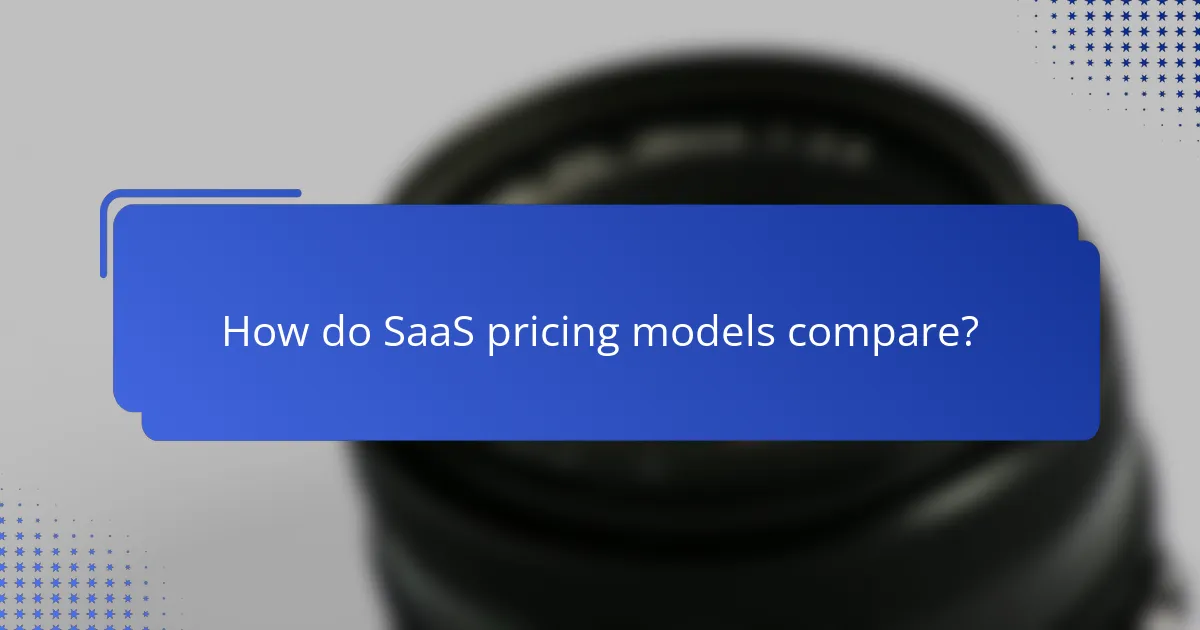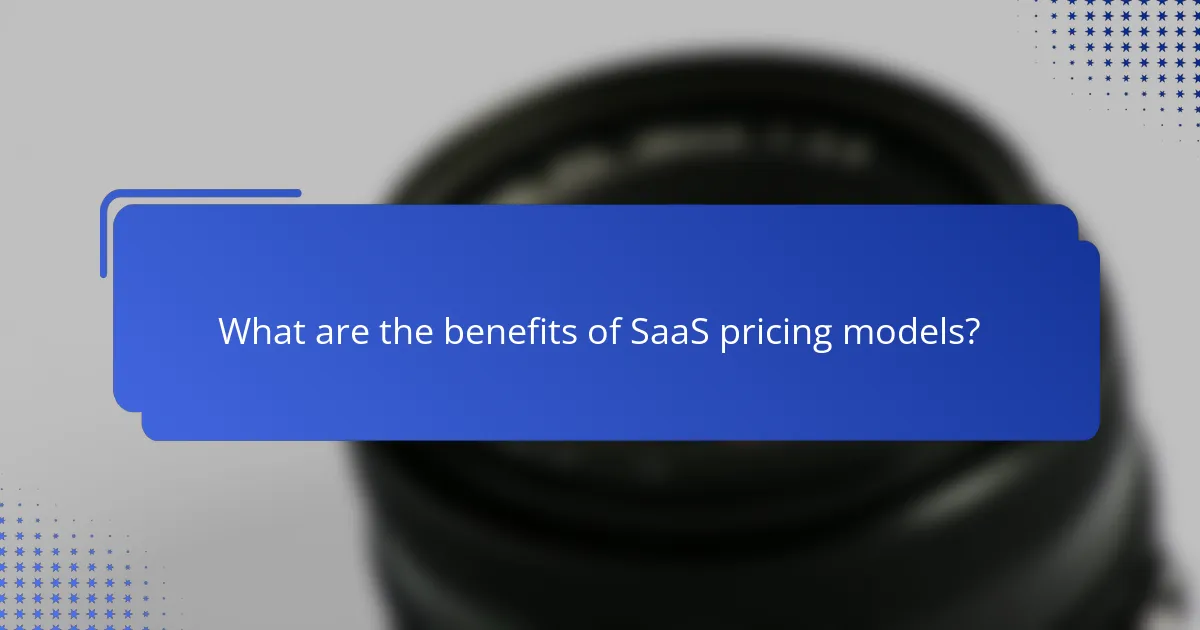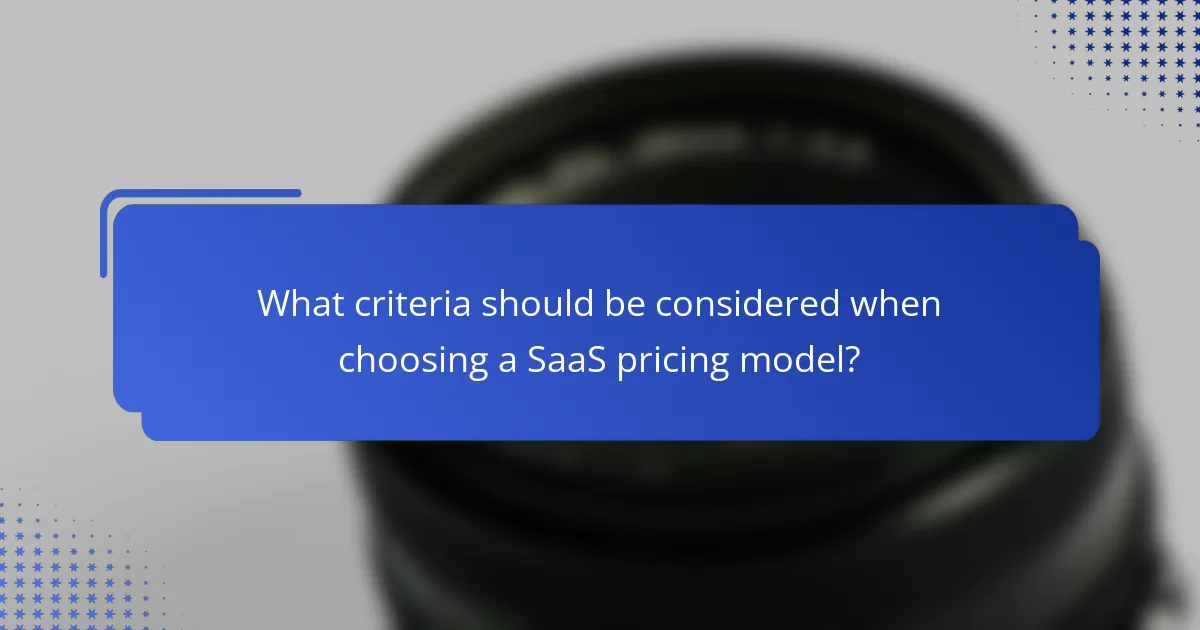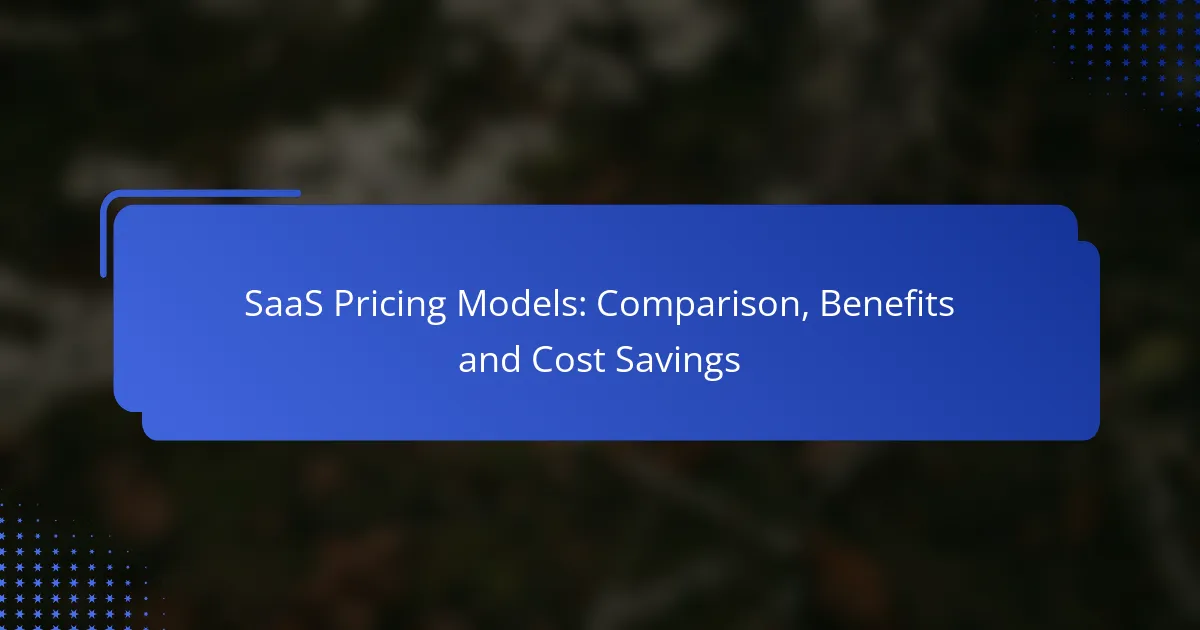SaaS pricing models provide businesses with various options to manage software costs effectively. Common models such as subscription-based, usage-based, freemium, tiered, and flat-rate pricing each come with unique benefits, allowing organizations to select the most suitable approach based on their specific needs and usage patterns. By understanding these models, companies can achieve predictable costs, flexibility for growth, and improved budget management.

What are the common SaaS pricing models in Canada?
In Canada, common SaaS pricing models include subscription-based, usage-based, freemium, tiered, and flat-rate pricing. Each model offers distinct advantages and considerations, allowing businesses to choose the best fit based on their customer needs and usage patterns.
Subscription-based pricing
Subscription-based pricing is one of the most prevalent models, where customers pay a recurring fee, typically monthly or annually, for access to the software. This model provides predictable revenue for providers and allows users to budget their expenses effectively.
Common subscription rates in Canada can range from CAD 10 to CAD 500 per month, depending on the features and services offered. Businesses should consider the length of commitment and any discounts for annual payments when choosing this model.
Usage-based pricing
Usage-based pricing charges customers based on their actual usage of the service, making it ideal for businesses with fluctuating needs. This model can be appealing for startups or smaller companies that want to minimize upfront costs.
For example, a cloud storage service might charge CAD 0.10 per GB stored per month. However, users should be cautious of potential spikes in costs during high usage periods, which can lead to budget overruns.
Freemium model
The freemium model offers basic features for free while charging for premium features or advanced functionalities. This approach allows users to try the product without financial commitment, which can lead to higher conversion rates for paid plans.
In Canada, many software companies use this model to attract users, but it’s essential to clearly communicate the limitations of the free version to avoid customer dissatisfaction. A common pitfall is not providing enough value in the free tier, which can hinder user engagement.
Tiered pricing
Tiered pricing offers multiple pricing levels, each with a different set of features and capabilities. This model caters to a wide range of customers, from small businesses to large enterprises, allowing them to select a plan that best fits their needs.
For instance, a SaaS provider might offer three tiers: Basic at CAD 20/month, Pro at CAD 50/month, and Enterprise at CAD 100/month. Businesses should evaluate their growth potential and scalability when choosing a tier to ensure they can upgrade as needed.
Flat-rate pricing
Flat-rate pricing charges a single fixed fee for access to the software, regardless of usage. This simplicity can be attractive for customers who prefer predictable costs without worrying about overages or additional fees.
However, flat-rate pricing may not be suitable for all businesses, especially those with varying usage patterns. Companies should assess whether this model aligns with their customer base and consider offering add-ons for users who may require more features or capacity.

How do SaaS pricing models compare?
SaaS pricing models vary significantly in structure and cost implications, affecting how businesses budget for software. Key models include subscription, usage-based, tiered, and freemium, each offering distinct advantages and considerations for users.
Cost comparison of subscription vs. usage-based
Subscription pricing typically involves a fixed monthly or annual fee, making budgeting straightforward. In contrast, usage-based pricing charges customers based on their actual consumption, which can lead to lower costs for infrequent users but higher expenses for heavy users.
For example, a subscription model might cost around $50 per month regardless of usage, while a usage-based model could charge $0.10 per transaction. Businesses should analyze their usage patterns to determine which model aligns better with their financial goals.
Benefits of tiered pricing
Tiered pricing offers multiple plans at different price points, allowing customers to choose based on their needs and budget. This model can attract a broader audience by catering to both small businesses and larger enterprises.
For instance, a SaaS provider might offer a basic plan at $20 per month, a standard plan at $50, and a premium plan at $100. This structure encourages upselling and helps customers easily scale their services as their needs grow.
Freemium model effectiveness
The freemium model allows users to access basic features for free while charging for advanced functionalities. This approach can effectively attract a large user base, as it lowers the barrier to entry.
However, converting free users to paying customers can be challenging. Companies should focus on providing enough value in the free version to entice users to upgrade, often by highlighting premium features that enhance productivity or efficiency.

What are the benefits of SaaS pricing models?
SaaS pricing models offer several advantages, including predictable costs, flexibility for growth, and reduced initial investment. These benefits make them appealing for businesses of all sizes, allowing for better budget management and resource allocation.
Predictable revenue streams
SaaS pricing models typically involve subscription fees, which create predictable revenue streams for providers. This consistency allows businesses to forecast income and plan for future investments more effectively.
For customers, predictable costs mean they can budget accurately without unexpected expenses. Monthly or annual subscriptions help organizations manage cash flow and allocate resources efficiently.
Scalability for businesses
SaaS solutions are designed to scale easily with a business’s growth. Companies can adjust their subscription plans based on their current needs, whether that means adding more users or accessing advanced features.
This scalability is particularly beneficial for startups and growing enterprises, as they can start with a basic plan and upgrade as their requirements evolve, avoiding the need for significant infrastructure changes or investments.
Lower upfront costs
One of the key advantages of SaaS pricing models is the lower upfront costs compared to traditional software purchases. Businesses typically pay a subscription fee rather than a large one-time payment, making it easier to adopt new technologies.
This model allows companies to access high-quality software without the burden of hefty initial investments, which can be crucial for small businesses or startups operating on tight budgets. Additionally, ongoing maintenance and updates are often included in the subscription, further reducing long-term costs.

How can SaaS pricing models lead to cost savings?
SaaS pricing models can significantly reduce costs for businesses by offering predictable expenses and eliminating the need for extensive infrastructure investments. By leveraging cloud-based solutions, organizations can optimize their spending and allocate resources more efficiently.
Reduced operational costs
SaaS solutions typically require lower upfront investments compared to traditional software, as they eliminate the need for hardware purchases and extensive IT support. Organizations can avoid costs related to server maintenance, power consumption, and physical space.
For example, a small business using a SaaS application may save thousands of dollars annually by not needing to maintain its own servers. This reduction in operational costs allows companies to redirect funds towards growth initiatives and other strategic priorities.
Minimized software maintenance
With SaaS, software maintenance is handled by the service provider, which means businesses do not need to allocate resources for updates, patches, or troubleshooting. This leads to significant time savings and allows IT teams to focus on more critical tasks.
Moreover, automatic updates ensure that users always have access to the latest features and security enhancements without additional costs. This model can save organizations both time and money, as they avoid the complexities of managing software lifecycles.
Flexibility in scaling
SaaS pricing models offer flexible scaling options, allowing businesses to adjust their subscriptions based on current needs. Companies can easily increase or decrease their usage, which means they only pay for what they actually use.
This flexibility is particularly beneficial for startups or businesses experiencing rapid growth, as they can scale their software solutions without incurring hefty costs associated with traditional licensing models. For instance, a company can start with a basic plan and upgrade as its team expands, ensuring cost-effectiveness at every stage of growth.

What criteria should be considered when choosing a SaaS pricing model?
When selecting a SaaS pricing model, consider factors such as your target market, customer needs, and the value your product delivers. It’s crucial to align your pricing strategy with your business goals and the competitive landscape.
Customer Segmentation
Understanding your customer segments is vital in choosing a SaaS pricing model. Different segments may have varying willingness to pay, usage patterns, and feature preferences. For instance, small businesses might prefer lower-tier plans with essential features, while larger enterprises may require advanced functionalities and are willing to invest more.
Consider creating tiered pricing plans that cater to different customer needs. This approach allows you to capture a broader audience while maximizing revenue from high-value clients.
Value Proposition
Your pricing model should reflect the value your SaaS product provides. Clearly articulate the benefits and features that justify your pricing. For example, if your software significantly reduces operational costs or improves productivity, ensure that these advantages are highlighted in your pricing strategy.
Utilizing value-based pricing can be effective, where you set prices based on the perceived value to the customer rather than solely on costs. This may involve conducting market research to assess how much customers are willing to pay for specific features.
Market Competition
Analyzing competitors’ pricing models is essential when determining your own. Look at how similar SaaS products are priced and what features they offer at different tiers. This insight can help you position your product competitively while ensuring you don’t undervalue your offering.
Consider adopting a pricing strategy that differentiates your product from competitors. For instance, if competitors offer annual subscriptions, you might provide flexible monthly plans to attract customers looking for lower commitment.
Cost Structure
Your internal cost structure will influence your pricing decisions. Understand your fixed and variable costs to ensure your pricing covers expenses while allowing for profit margins. This includes costs related to infrastructure, support, and development.
Establishing a break-even analysis can help determine the minimum price point needed to cover costs. Additionally, consider pricing models that allow for scalability, such as usage-based pricing, which can adjust according to customer consumption.
Regulatory Considerations
Depending on your target market, be aware of any regulatory requirements that may impact your pricing model. For example, certain industries may have compliance costs that need to be factored into your pricing strategy.
Ensure your pricing practices comply with local regulations, such as consumer protection laws and tax obligations. This is particularly important when operating in multiple countries, as pricing strategies may need to adapt to varying legal environments.
